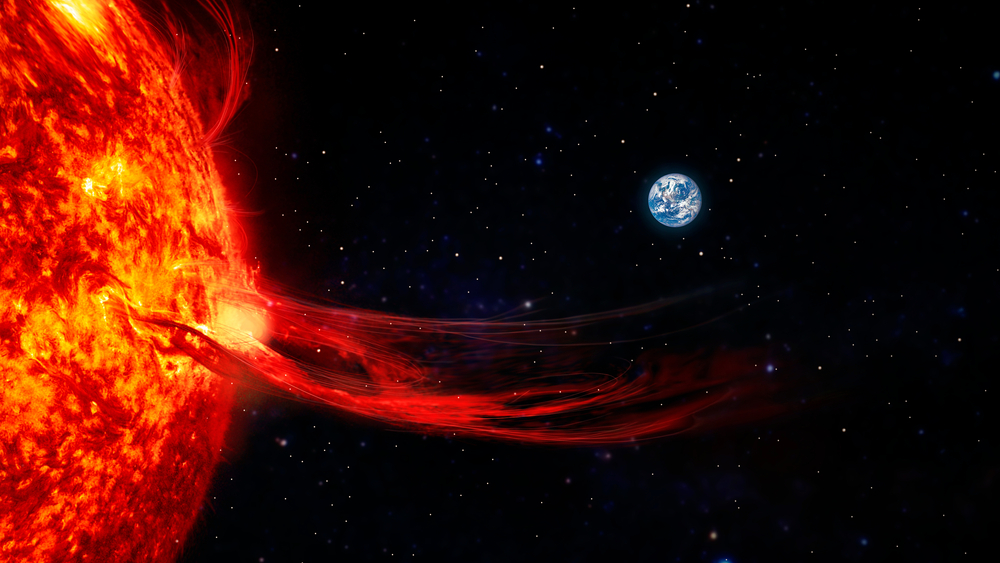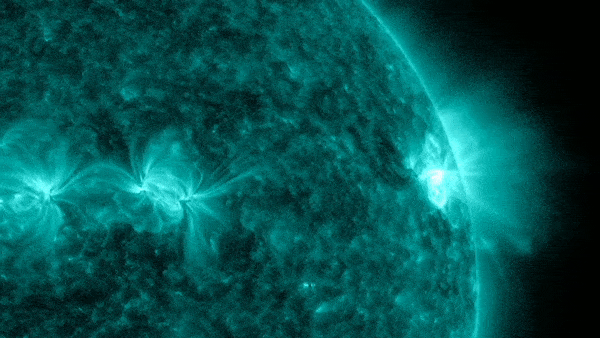Massive, hidden sunspot blasts out potential X-class flare — and Earth could soon be in the firing line
Astronomers recently detected a massive explosion on the far side of the sun, which may have spat out one of the most powerful flares the sun can produce.

A massive explosion on the far side of the sun recently spat out a potential X-class flare — one of the most powerful solar flares the sun is capable of producing. The resulting solar storm will narrowly miss Earth, but the sunspot responsible for belching it out could soon be pointed directly at our planet.
The epic eruption was detected on Jan. 3 by the Solar and Heliospheric Observatory (SOHO), an Earth-orbiting spacecraft co-operated by NASA and the European Space Agency. SOHO spotted a bright stream of plasma, known as a coronal mass ejection (CME), that emerged from the sun's southeastern limb, according to Spaceweather.com.
The CME was likely given off by a hidden far-side flare and registered as a C-class event, the third highest class of solar flares. (Solar flare classes include A, B, C, M and X, with each class being at least 10 times more powerful than the previous one.) But based on the size and strength of the visible CME, experts believe the hidden outburst that birthed it was probably large enough to be designated as an X-class flare, Spaceweather.com reported. But this has not been officially confirmed.
The most powerful X-class flares can erupt from the sun with an equivalent force of around a billion hydrogen bombs, according to NASA. If one of these flares hit Earth head on it could trigger widespread radio and electricity blackouts on the side of the planet facing the sun and cause damage to satellites in orbit around Earth. The resulting auroras would be so strong they could even give nearby airplane passengers small doses of radiation, according to NASA.
Scientists from the National Oceanic and Atmospheric Administration (NOAA) modeled the solar storm given off by the most recent X-class flare and found that it would narrowly miss Earth over the next few days, according to Spaceweather.com. However, that doesn't mean we will stay in the clear for long.
Related: 10 solar storms that blew us away in 2022

Astronomers believe the enormous flare was emitted from a sunspot — dark, planet-sized regions that form in the sun’s lower atmosphere as the result of magnetic disturbances — known as AR3163, which rotated onto the far side of the sun around two weeks ago after spitting out a flurry of mild CMEs on the sun's near side. Based on the potential power of the hidden flare, experts think the sunspot has grown significantly in size since it disappeared from view, Spaceweather.com reported.
Sign up for the Live Science daily newsletter now
Get the world’s most fascinating discoveries delivered straight to your inbox.
When the recent flare erupted, AR3163 was predicted to reemerge onto the near side of the sun within two days based on acoustic images, known as helioseismic echoes, which can detect abnormalities on the hidden surface of the sun. On Jan. 5, the closest edge of AR3163 began to appear on the solar horizon as expected, according to Spaceweather.com. It will soon be pointed directly at Earth and has the capacity to spit out more X-class flares, but the chances of a direct hit are relatively low.
Earth is currently at perihelion, meaning that our planet is at its closest point to the sun. On Jan. 4, another CME given off by an M-class flare, which was capable of causing minor radio blackouts, bashed into Earth right as the planet moved into its closest possible proximity to the sun.
Solar activity will continue to ramp up as we approach the peak of the sun's 11-year solar cycle, which will occur in 2025. During December 2022 there were 24 active sunspots on the sun, the highest number for more than seven years, according to Spaceweather.com.
Editor's Note: Updated at 10:05 a.m. EST on Jan. 6 to clarify that the X-class flare wasn't officially confirmed. But a second confirmed X-class flare was emitted by the same sunspot on Jan. 6, according to Spaceweather.com.

Harry is a U.K.-based senior staff writer at Live Science. He studied marine biology at the University of Exeter before training to become a journalist. He covers a wide range of topics including space exploration, planetary science, space weather, climate change, animal behavior and paleontology. His recent work on the solar maximum won "best space submission" at the 2024 Aerospace Media Awards and was shortlisted in the "top scoop" category at the NCTJ Awards for Excellence in 2023. He also writes Live Science's weekly Earth from space series.









